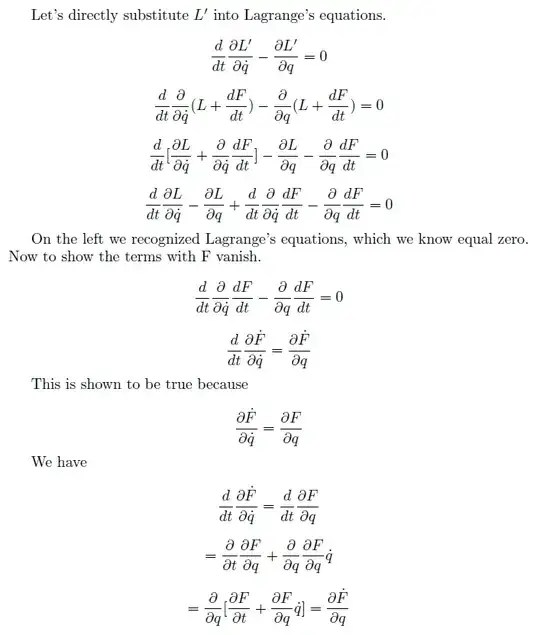If you follow some of the steps in the derivations, you might wonder where the importance of the time derivative of $F$ matters. One of the equations presented in the question, the one under where it says "it is shown to be true because" is the key. This equation says:
$\frac{\partial \dot{F}}{\partial \dot{q}}=\frac{\partial F}{\partial q}$.
This equation says, although not obviously, that the last two terms in the fourth equation in the question, notably this equation:
$ \frac{d}{d t} \frac{\partial L}{\partial \dot{q}}-\frac{\partial L}{\partial q}+\frac{d}{d t} \frac{\partial}{\partial \dot{q}} \frac{d F}{d t}-\frac{\partial}{\partial q} \frac{d F}{d t}=0 $.
are in fact equal and thus cancel. So you are left with
$\frac{d}{d t} \frac{\partial L}{\partial \dot{q}}-\frac{\partial L}{\partial q} = 0$
From that you can get the equations of motion, just as you would with $L'$. So $L'$ and $L$ give the same equations of motion.
But to get why the time derivative of $F$ is important, and not just $F$, lets start with the third term which is $\frac{d}{d t} \frac{\partial}{\partial \dot{q}} \frac{d F}{d t}$ and write it as $\frac{d}{d t} \frac{\partial}{\partial \frac{d}{dt}{q}} \frac{\frac{d}{dt} F}{1}$. Now you can see that we are taking the partial of the rate of change of $F$ with respect to the rate of change of $q$. Also not stated in the question, it is required that $F$ is a function of $t$ and $q$. That is $F=F(q,t)$
So we can dump the rate of change part and just keep the derivative of $F$ w.r.t. $q$ and get $\frac{d}{d t} \frac{\partial}{\partial {q}} F$, which is $ \frac{\partial}{\partial {q}} \frac{d F}{d t}$ which is the same as the fourth term and therefore they cancel one another.
Without the $d/dt$ in front of $F$ this would not have worked. So, adding to the Lagrangian a total time derivative of a function of $q$ and $t$ does not change the equations of motion

